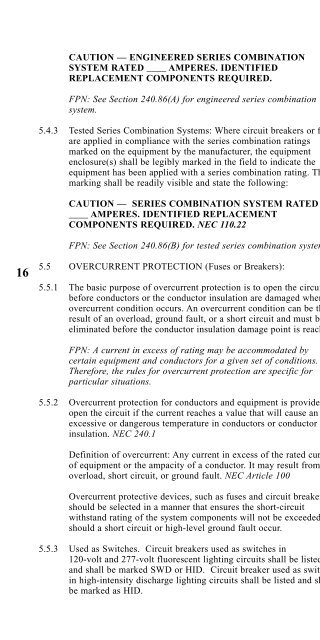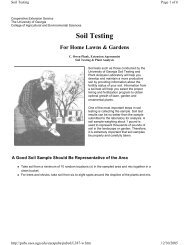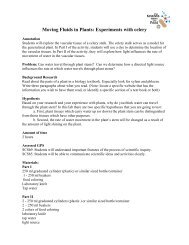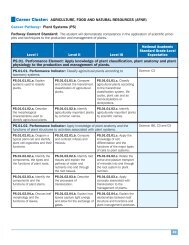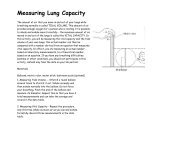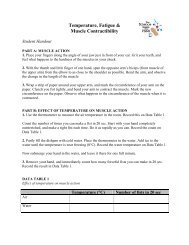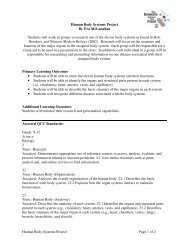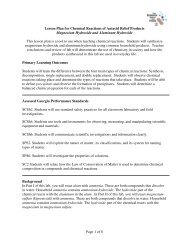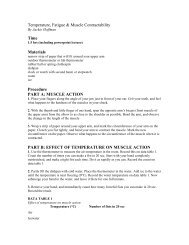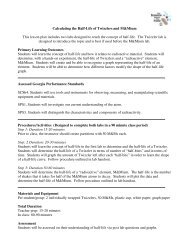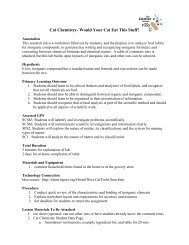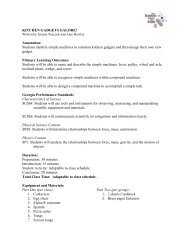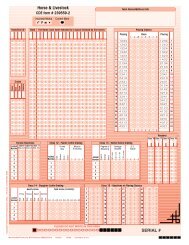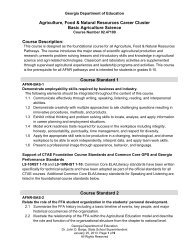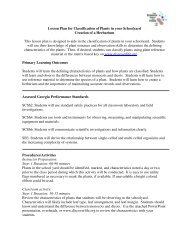EMC Student Wiring Guide - the Georgia Agriculture Curriculum ...
EMC Student Wiring Guide - the Georgia Agriculture Curriculum ...
EMC Student Wiring Guide - the Georgia Agriculture Curriculum ...
Create successful ePaper yourself
Turn your PDF publications into a flip-book with our unique Google optimized e-Paper software.
CAUTION — ENGINEERED SERIES COMBINATION<br />
SYSTEM RATED ____ AMPERES. IDENTIFIED<br />
REPLACEMENT COMPONENTS REQUIRED.<br />
FPN: See Section 240.86(A) for engineered series combination<br />
system.<br />
5.4.3 Tested Series Combination Systems: Where circuit breakers or fuses<br />
are applied in compliance with <strong>the</strong> series combination ratings<br />
marked on <strong>the</strong> equipment by <strong>the</strong> manufacturer, <strong>the</strong> equipment<br />
enclosure(s) shall be legibly marked in <strong>the</strong> field to indicate <strong>the</strong><br />
equipment has been applied with a series combination rating. The<br />
marking shall be readily visible and state <strong>the</strong> following:<br />
CAUTION — SERIES COMBINATION SYSTEM RATED<br />
____ AMPERES. IDENTIFIED REPLACEMENT<br />
COMPONENTS REQUIRED. NEC 110.22<br />
6. BRANCH CIRCUIT WIRING<br />
6.1 LENGTH OF FREE CONDUCTORS AT OUTLETS, JUNCTIONS,<br />
AND SWITCH POINTS:<br />
6.1.1 At least 150 mm (6 in.) of free conductor, measured from <strong>the</strong> point<br />
in <strong>the</strong> box where it emerges from its raceway or cable sheath, shall<br />
be left at each outlet, junction, and switch point for splices or <strong>the</strong><br />
connection of luminaries (fixtures) or devices.<br />
6.1.2 Where <strong>the</strong> opening to an outlet, junction, or switch point is less<br />
than 200 mm (8 in.) in any dimension, each conductor shall be long<br />
enough to extend at least 75 mm (3 in.) outside <strong>the</strong> opening.<br />
NEC 300.14<br />
Exception: Conductors that are not spliced or terminated at <strong>the</strong><br />
outlet, junction, or switch point shall not be required to comply<br />
with 300.14.<br />
16<br />
FPN: See Section 240.86(B) for tested series combination system.<br />
5.5 OVERCURRENT PROTECTION (Fuses or Breakers):<br />
5.5.1 The basic purpose of overcurrent protection is to open <strong>the</strong> circuit<br />
before conductors or <strong>the</strong> conductor insulation are damaged when an<br />
overcurrent condition occurs. An overcurrent condition can be <strong>the</strong><br />
result of an overload, ground fault, or a short circuit and must be<br />
eliminated before <strong>the</strong> conductor insulation damage point is reached.<br />
FPN: A current in excess of rating may be accommodated by<br />
certain equipment and conductors for a given set of conditions.<br />
Therefore, <strong>the</strong> rules for overcurrent protection are specific for<br />
particular situations.<br />
6.2 MECHANICAL AND ELECTRICAL CONTINUITY —<br />
CONDUCTORS:<br />
6.2.1 General: Conductors in raceways shall be continuous between<br />
outlets, boxes, devices, and so forth. There shall be no splice or tap<br />
within a raceway unless permitted by 300.15; 368.8(A); 376.56;<br />
378.56; 384.56; 386.56; 388.56; or 390.6. NEC 300.13(A)<br />
6.2.2 Device Removal: In multiwire branch circuits, <strong>the</strong> continuity of a<br />
grounded conductor shall not depend on device connections such as<br />
lamp holders, receptacles, and so forth, where <strong>the</strong> removal of such<br />
devices would interrupt <strong>the</strong> continuity. NEC 300.13(B)<br />
6.3 SPLICES:<br />
17<br />
5.5.2 Overcurrent protection for conductors and equipment is provided to<br />
open <strong>the</strong> circuit if <strong>the</strong> current reaches a value that will cause an<br />
excessive or dangerous temperature in conductors or conductor<br />
insulation. NEC 240.1<br />
Definition of overcurrent: Any current in excess of <strong>the</strong> rated current<br />
of equipment or <strong>the</strong> ampacity of a conductor. It may result from<br />
overload, short circuit, or ground fault. NEC Article 100<br />
6.3.1 Conductors shall be spliced or joined with splicing devices<br />
identified for <strong>the</strong> use or by brazing, welding, or soldering with a<br />
fusible metal or alloy. Soldered splices shall first be so spliced or<br />
joined as to be mechanically and electrically secure without solder<br />
and <strong>the</strong>n soldered. All splices and joints and <strong>the</strong> free ends of<br />
conductors shall be covered with insulation equivalent to that of <strong>the</strong><br />
conductors or with an insulating device identified for <strong>the</strong> purpose.<br />
NEC 110.14(B)<br />
Overcurrent protective devices, such as fuses and circuit breakers,<br />
should be selected in a manner that ensures <strong>the</strong> short-circuit<br />
withstand rating of <strong>the</strong> system components will not be exceeded<br />
should a short circuit or high-level ground fault occur.<br />
5.5.3 Used as Switches. Circuit breakers used as switches in<br />
120-volt and 277-volt fluorescent lighting circuits shall be listed<br />
and shall be marked SWD or HID. Circuit breaker used as switches<br />
in high-intensity discharge lighting circuits shall be listed and shall<br />
be marked as HID.<br />
6.3.2 Where circuit conductors are spliced within a box, or terminated on<br />
equipment within or supported by a box, any separate equipment<br />
grounding conductors associated with those circuit conductors shall be<br />
connected or joined within <strong>the</strong> box or to <strong>the</strong> box with devices suitable<br />
for <strong>the</strong> use in accordance with NEC 250.148(A) through (E).<br />
6.3.3 A box or conduit body shall be installed at each conductor splice,<br />
connection point, outlet point, switch point, junction point,<br />
termination point or pull point unless o<strong>the</strong>rwise permitted in<br />
NEC200.15(A) through (M).


